#tutorial de tarot
Explore tagged Tumblr posts
Text
¿Quieres ser un tarotista profesional y ayudar a las personas a sanar?
¡Con este curso podrás hacerlo!
#curso de tarot#tarot#aprender a leer el tarot#aprender tarot#como leer las cartas#curso tarot#como leer el tarot#aprender a leer las cartas del tarot#leer el tarot#tarot consejos#tutorial de tarot#clases de tarot#curso#emprender#emprendimiento#cursotarot
0 notes
Text
Reflection
From last week tutorial, I gathered that I was being too scattered and kept on changing directions too many times. This very relevant observation was difficult to realise. I wasn’t happy with the <<progress>> of the work I had made, and lost track of where I was going and what I was doing.
This week I deeply reflected on what truly interested me and what I really wanted.
My work directed towards “form over content” wasn’t made intentionally; I took that direction because of my incapacity to find a “content” that I would feel truly invested or interested in. I felt insecure towards a more personal approach to my work as opposed to something more academic.
“What is the use of creating emotion-based work?”, was a recurrent question that came to my mind.
The constant switch between visual styles was also a struggle of mine as I was paradoxically trying to “please others”, in the sense that I wanted to create something that would be liked by a bigger audience.
I felt confused by the terms “position”, “practice” and “critical position”. Do I really need to define them this soon, is there even a need to define them? Is it wrong to be or feel lost?
Maybe the sense of loss or the loss of self could be a position?
I have always been quite precious with my work and value quality over quantity, and this entire project has been difficult for me so far as the whole point of it is to produce at a high volume (which I haven’t been successful with, at all).
The reason why last tutorial didn’t go well in my opinion (in terms of what I had done), is that I tried to change direction again, out of indecisiveness and my fear of making “meaningless work”. I tried to switch the direction towards something I thought would be more lighthearted but also something that would be more accepted.
I realised this week that I had to find a way to ground myself, and after writing my essay and doing research, I realised that I was clearly more interested in personal and intimate work.
I remember being particularly confused after reading “the death of the author” and it really made me question my own position: am I an author? Is authorship really dead? Is it really impossible to be an author at all?
These questions aside, I was also wondering if it was “wrong” to create around oneself, and if it was really an egotistical and selfish act.
So instead of thinking about how people would perceive me based on the work I produce (something that holds me back a lot), I started thinking about the artists I like and the art they make or made.
I have also been significantly drawn to my Moroccan and French heritage and how I could potentially implement elements of my heritage into my work in subtle ways, and maybe merge them together.
I have been researching around Moroccan female artists specifically.
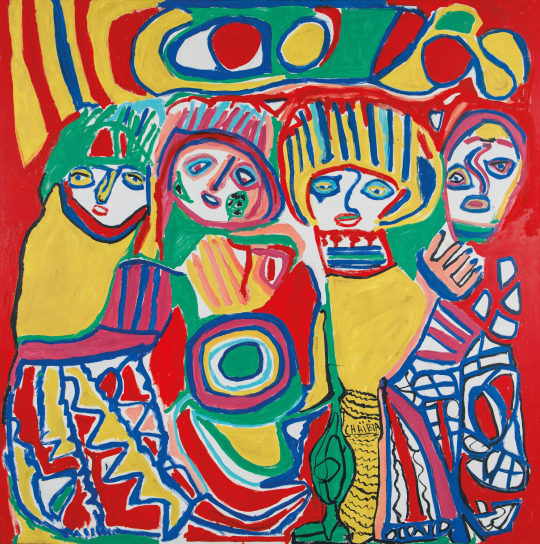
One of them is Chaibia Talal, one of the most influential Moroccan artists of the 20th century. Her story is especially extraordinary and touching. She was born in 1929 in a small village and married at age 13; her husband died when she was 15 years old. As a young widow and mother, she had no choice but to work as a cleaner in order to sustain herself and her son. She was illiterate.
She began painting in 1963 after having a “prophetic” dream that encouraged her to start painting. Her son had a painting studio, and that is where the art curator Pierre Gaudibert discovered her art work for the first time.
Chaibia Talal was a self-taught artist and she was exhibited all around the world. Although her work wasn’t well received in her time, she is now considered as a pioneer figure of Modern Moroccan Art.
The reason why it is important for me to talk about this artist comes from a need to discover more other Moroccan female artists that I can look up to.
Her work is extremely colourful; she was influenced by the “COBRA” avant-garde European art movement, but also pulled a lot of her themes from moroccan culture, depicting moroccan women in traditional costumes. There is an evident play with figuration and abstraction, and the very consistent use of patterns is also an echo to moroccan culture and craft.
Pattern making and symbols are an inherent part of Moroccan culture, even before it was a country. The west part of North Africa was actually constituted of nomadic Berbers.
These nomadic group of people would worship different divinities and symbols would be used both as protection, directly on the skin in the form of tattoos, or on the fabric they made and wore. Clothing was especially important as it was an indication not only of social status, class and wealth but also an indication of the nomadic group they belonged to.
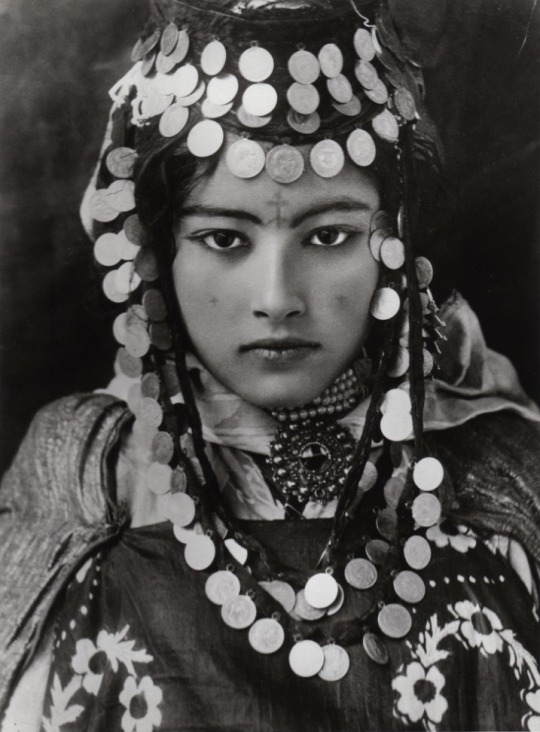
Symbols had associated meaning with different purposes.

Pattern making became even richer after Islamic influences arrived in North Africa. Indeed, it is prohibited in the religion to depict God or any divine figure to Man’s image. Subsequently, symbols and patterns were used to palliate to this. Calligraphy was, and still is, a highly valued form of art; Koranic texts would be embellished and treated as images as opposed to just writing.


Geometry and symmetry was seen as a high form of art as well; there is an element of repetition, interlacing shapes, texts, and symbols that is prevalent throughout Moroccan Art, and craft History.

Symbols have always interested me whether it be part of my heritage, or other new found interests, such as the occult. I have always been fascinated by how different meanings and interpretations can be pulled out of one image or symbol. How visuals can be transformed and used as a new form of language.
There is also a very superficial reason to this as well. There is something about looking at an accumulation of symbols on one images that is, to me, pleasing to the eye. Even if I can’t necessarily fully comprehend the artist’s intention behind every details of their work, I naturally associate a meaning to it based on my own experience and subjectivity.
A good example of this would be Hieronymus Bosch’s “The Garden of Earthly Delights”.

I am aware of its religious ties, and there are extended interpretations made of this triptych oil painting. Yet, I much prefer look at it and create my own narratives out of the images and symbols I can observe from it. I enjoy the fact that there are a multitude of narratives enfolding on one big image.
In tarot as well, each card is illustrated with specific visuals that aid in the interpretation of its messages. The cards, put side by side, form a narrative that is enriched by a diversity of symbols.
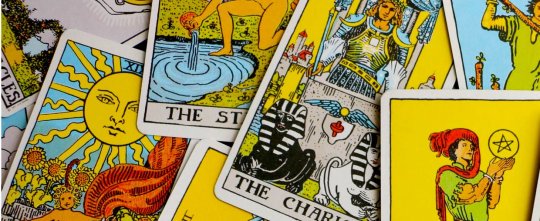
Folklore too, have consistently used symbols and metaphorical analogies to express a deeper meaning.
The French fabulist Jean de la Fontaine is well known for using animals, insects and plants to convey more sensitive messages, at a time where criticising the King and his court was a real offence and a punishable crime.

After listing down all of the things that I loved, I realised that they weren’t so impossible to connect. At a first glance, they seemed impossible to link, but they all share a similarity: they all use symbols and images to attach personal meanings to them or convey certain messages or narratives.
In conclusion, I would like to develop my own “Visual Dictionary/Library”, or at least start this process.
Through this project, my aim refocused on its intended purpose, which was the expression of self through a diverse set of symbols and images.
By doing so, I go back to my very early iterations from Elaborate, where my work was more emotion-based; I intend on keeping the idea of self-reflection through making and researching, in order to develop my own visual language.
10 notes
·
View notes
Text
'I have this feeling that Tarot cards were originally read much more like the linguistic method used for Lenormand cards. The Rider-Waite-Smith illustrated Minor Arcana cards and the Golden Dawn’s focus on visual–mythological interpretations of the Tarot images seems to have led to a more psychological and spiritual journey set of interpretations over the past century or so.
'The Tarot’s Original Pip Cards
'The Major Arcana have always stood out on their own as individual spiritual messengers, but the Minors were originally just symbols and numbers (they came from playing cards) with traditional meanings unrelated to any “picture” or “story,” like they still are in the Tarot de Marseille decks, which Jean Noblet developed in 1650. [...]'
Visit the TABI website to read the rest of the post!
4 notes
·
View notes
Text
Final Project
For our final project, I decided to go with Self-Identity, and attempted to develop my own personal brand.
We were told to approach the project with a specific career in mind; since I’m quite active in my art-making, I chose to market myself as an artist, with ‘Kahlieste’ being my art brand/ pseudonym that I’ve used for a while now.
Ideation Process
I began by running a few of my existing works through a color scheme generator, just to see if there were any common threads that could help me develop a brand genuinely representative of my identity as an artist.
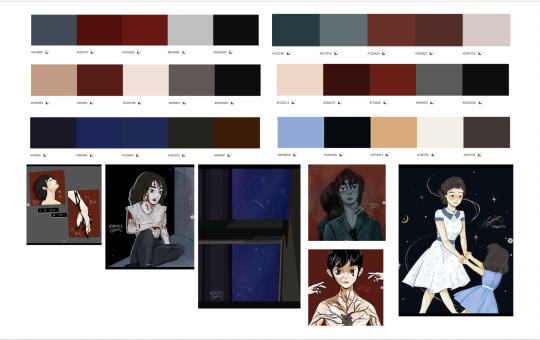
Generally speaking, a good number of my art is red, black, greyish, and cream, with something creeping up the characters, or blood dripping. Which was a problem, because I don’t exactly want potential employers to perceive me as broody or creepy. The somewhat more positive works had elements of galaxies or the night sky, but also mainly used dark colors as a backdrop. Thus, I chose to preserve these elements: darkness and night, in my final.
I was particularly drawn to the color scheme at the bottom right, the gold, cream, and black. My classmates also liked that choice, and commented that the colors would complement each other well.
With these ideas in mind, I took inspiration from tarot cards, and astronomy symbols. This was my moodboard:

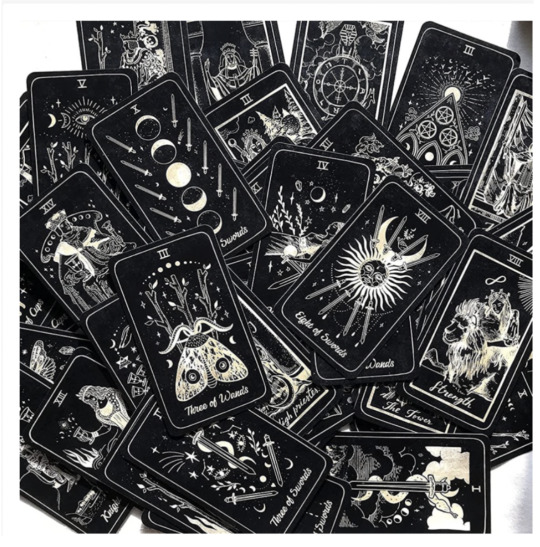
For one of our tutorials, we were told to come up with a Word Cloud, which was 6 words describing our concept. Here are some ideas that I wanted my brand to reflect:
1. Unique/ distinct
2. Dark/ominous
3. Shadows/ night
4. Elegant/ sophisticated
5. Classic/ornate
6. Bold/edgy
7. Strange/eccentric
(yep, it’s a lot more than 6 words)
I also referenced Ivy Lane’s brand style guide, which is an alternative/ bougie wedding planning company. Ivy Lane used many of the same themes as I intended to, so it was very helpful and interesting to observe the way they presented their brand. I was especially drawn to their brand because of their golden skull logo (pictured below), above a black background. This was generally along the lines of what I was going for, so it was cool. (I didn’t rip them off though, here’s their link you can check: https://issuu.com/corinnealexandra/docs/ile-brandguide)

Primary Logo Sketches:
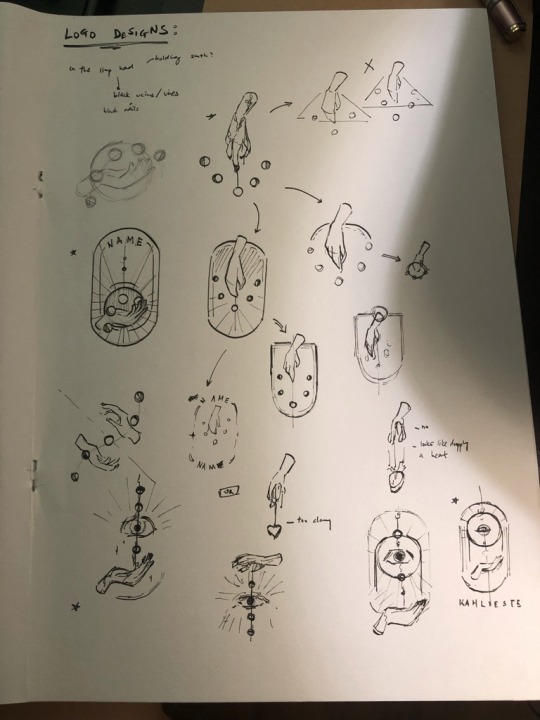
Original Logo Designs:
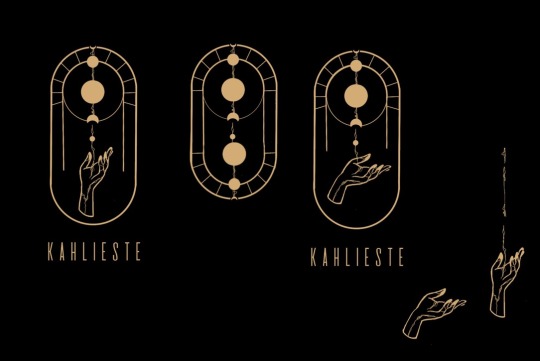
I was determined to retain the image of a hand in my logo; most of my art is about people, or it has human figures in it, so this was a way for me to preserve that element. Also, hands are commonly seen in tarot card designs, so this stayed consistent with the theme. I subsequently had the idea to have the moon phases ‘drip’ from the hands, or sprout from the hand through vines. I thought this was consistent with the theme of my works, but communicated it more subtly than with red or blood. I also considered the hand’s pose, and decided on the logo on the right - the composition seemed more balanced, and was comfortably spaced with the bottom border, unlike the one on the left.
Primary Name Card Drafts:
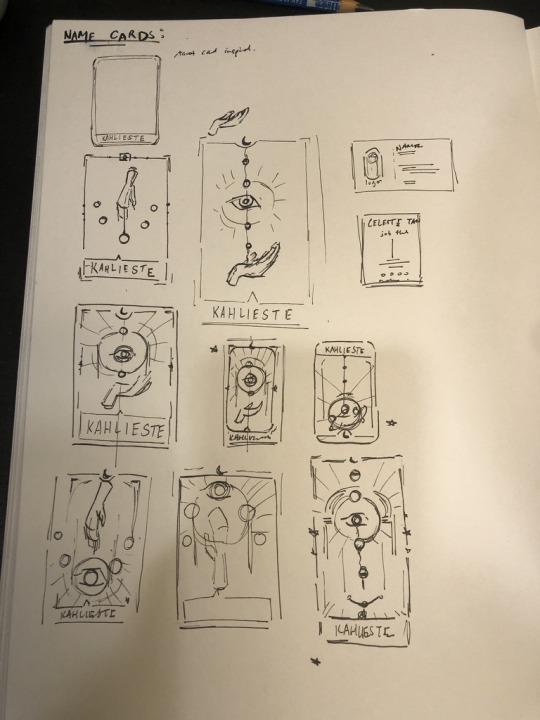
Font Choices:
I downloaded and experimented with a lot of fonts, before deciding on the best ones.
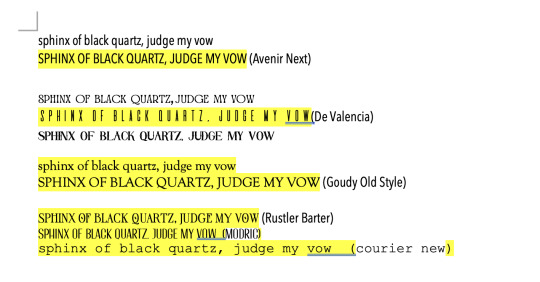
I wanted my brand to have a classic feel, but I also didn’t want it to look dated. I tried some serif fonts, but they didn’t seem to complement my logo, which was very geometric in nature. More ‘vintage’, ‘theatrical’ fonts also seemed a bit too overpowering. Ultimately, I decided that the san serif fonts made my logo look more modern and clean, and settled on De Valencia for the Titles and Headings, with Courier New for the subheadings (in all caps), and the body text (sentence case.)
For context, “Sphinx of Black Quartz, Judge my Vow” is just an edgier, more pretentious version of “the quick brown fox jumps over the lazy dog.”

(Some of my rejected fonts tried out on my original name card draft)

I also considered the sizing of by brand name, and how cohesive it would look within the design.
Original Color Scheme:
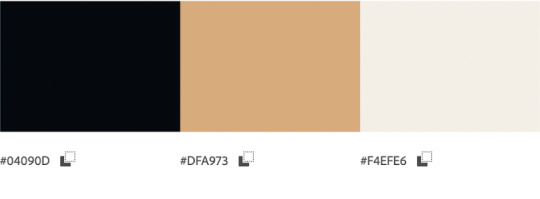
Original Name Card:
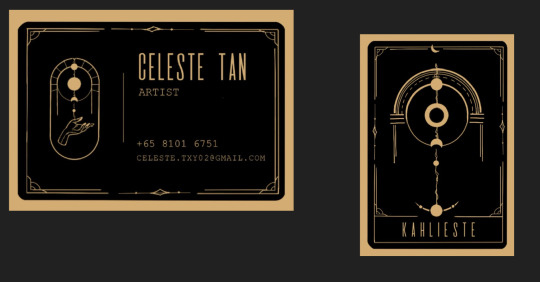
Critique:
Following critique from class, I redesigned the name card such that the information on the back would also be in portrait orientation, for consistency. I also added in a secondary ‘light’ version - my dad commented that printing on black is expensive, and I thought it was good to have an alternative.
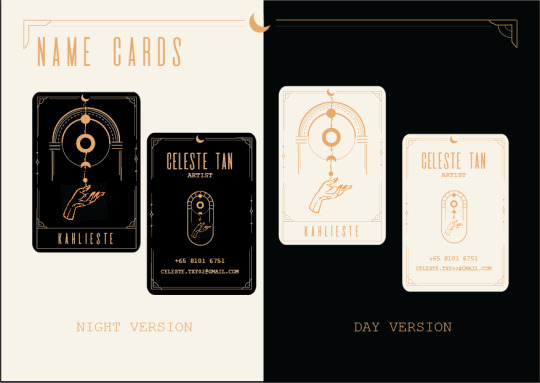
My primary concern was about legibility, and that the gold wasn’t as contrasting against the white/cream color as it was against the black. During critique, my classmates commented that the gold was still clearly legible, but it was true that the contrast was weakened. In response, I added another shade of gold to the color scheme, to be used against the white.
Here’s the before and after:

Updated Color Scheme:

Also, instead of purely using the new, darker gold against the white, I also used it in my brand guide for some of the subheadings, in order to contrast with the body text. I thought that the extra color added some depth to the guide, and made the text more readable. (Personally, I hate reading big chunks of text, so this made it less overwhelming.)
Other critique was about the finer details, like improving the pdf quality and consistently arranging the elements on the brand guide itself, both of which have been corrected before the final submission.
How Adobe was used:
In this project, I primarily used Adobe Illustrator to create the logo, the name cards, and really most of the deliverables.
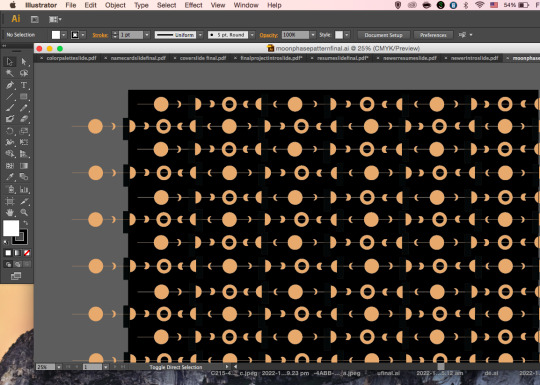
An example would be how I created the moon phase pattern on my final slide. Same process as usual, ellipse tool, line tool, direct selection - change line and fill colour. But an exciting new thing I learnt (should’ve learnt earlier) was using the scissors tool to cut the circles in half. I used to just create a rectangle and put it over half the circle, but I’m smarter now. This way’s way easier.
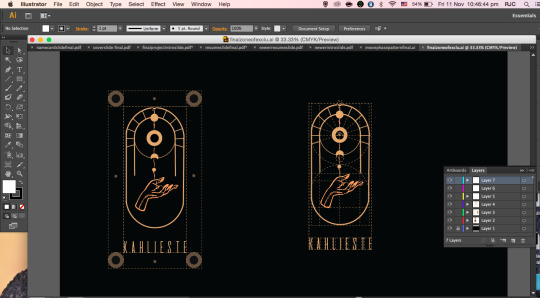
Same goes for how I created the logo grid and the zone of exclusion. I used a combination of the rectangle and the line tools, and changed the lines into dotted lines on the properties panel > stroke > dashed line. This was really fun for me. I was about to DIY my dotted lines by making like.. 1000 little rectangles. Good thing I googled it first, you know. For the zone of exclusion, I copied and pasted the middle moon into the 4 corners, then lowered their transparency. Fun times.
These elements and more were saved, and as required, InDesign was used to assemble the final pdf:
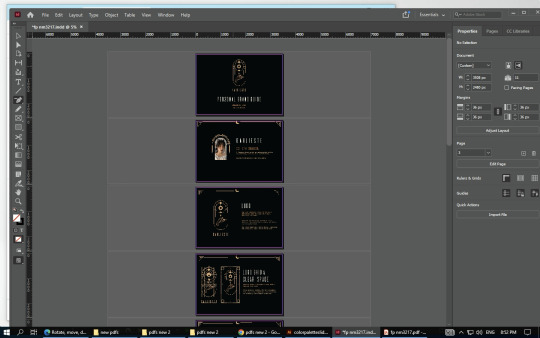
It was fun! Ok it was really challenging, but I did enjoy the process. Thanks for the semester, I had a good time.
0 notes
Photo

"Para nos comunicarmos bem precisamos compreender que somos todos diferentes na maneira de interpretar o mundo, e usar essa informação como um tutorial para o nosso entrosamento com os outros". _ Anthony Robbins /// /// /// "To effectively communicate we must realize that we are all different in the way we perceive the world and use this understanding as a guide to our communication with others". _ Anthony Robbins /// /// /// Lenormand Card 27 Letter / Carta: "Sylvie Steinbach STS Lenormand Oracle", created by Sylvie Steinbach #cartomancy #tarot #tarotreadersofinstagram #oraclereadersofinstagram #oracle #divination #cardreading #cartomancersofinstagram #oraclecards #spiritual #spirituality #oracledecks #intuition #intuitive #esoterismo #esoterism #esoteric #quoteoftheday #inspirationalquotes #alextarologo #tarologo #baralho #cartomante #sylviesteinbach #letter #notice #communication #written #anthonyrobbins #envelope https://www.instagram.com/p/CPPprhpnj_p/?utm_medium=tumblr
#cartomancy#tarot#tarotreadersofinstagram#oraclereadersofinstagram#oracle#divination#cardreading#cartomancersofinstagram#oraclecards#spiritual#spirituality#oracledecks#intuition#intuitive#esoterismo#esoterism#esoteric#quoteoftheday#inspirationalquotes#alextarologo#tarologo#baralho#cartomante#sylviesteinbach#letter#notice#communication#written#anthonyrobbins#envelope
0 notes
Photo

¡Tenemos Challenge! @vi.morfin / @tomlinsonsquirrel y yo tenemos en conjunto un challenge dónde te invitamos a recrear a cada una de las reinas del tarot. En sus cuentas ella va a subir el tutorial para que puedas recrear su maquillaje inspirado en la reina de espadas. Participa subiendo a tus historias o en tu perfil tu foto o video luciendo el maquillaje y usando #tarotmakeupchallenge sube y etiquetándonos a las dos. ✨Puede que te ganes una sesión de tarot conmigo 🌟 #love #crystals #spiritual #yoga #meditation #thirdeye #goodvibes #chakras #happy #energy #healing #crystalhealing #wisdom #peace #psychic #minerals #awakening #tarot #gems #meditate #metaphysical #om #consciousness #happiness #loveandlight #healingcrystals #zen #tarotcards https://www.instagram.com/p/CERzRySD1FH/?igshid=hcpvxzn7c3h7
#tarotmakeupchallenge#love#crystals#spiritual#yoga#meditation#thirdeye#goodvibes#chakras#happy#energy#healing#crystalhealing#wisdom#peace#psychic#minerals#awakening#tarot#gems#meditate#metaphysical#om#consciousness#happiness#loveandlight#healingcrystals#zen#tarotcards
0 notes
Photo

CURSO A DISTANCIA DESDE LA COMODIDAD DE TU HOGAR Y SIN CUMPLIR HORARIOS!!! TUTORIAL PERMANENTE Y PERSONALIZADO!!! PARAPSICOLOGÍA Temas desarrollados en el Curso: Papel y Objetivos del Parapsicólogo Hay un Brujo en tu Interior Clarividencia Precognición Telepatía Estar en 2 Lugares al Mismo Tiempo Telequinesis Psikinesis Bilocación Levitación Ectoplasmia Fantasmogénesis Dotes Extrasensoriales Niños con Poderes Telepatía en Hermanos Gemelos Técnicas para Aumentar el Poder de la Mente Desarrollo PSI Los Sueños Sueños Parapsicológicos Sueños Proféticos Sueños Anticipatorios Sueños de la Personalidad Sueños Compensatorios Sueños del Inconsciente Colectivo Clasificación Junguiana de los Sueños Sueños Anticipatorios Sueños Traumáticos Sueños Extrasensoriales Sueños Paralelos Sueños Proféticos Relaciones entre Precognición y Profecías Hundimiento del Titanic Las Velas descubren tu Futuro Los Vaticinios El Tarot y la Parapsicología Querés saber si tu Pareja te es Fiel? Aparición de Feng Parapsicológicos El Diablo y los Parapsicólogos Exorcismo Poltergeist Curas Milagrosas Desarrollo de Células Curar a Mascotas Tratamiento de Belleza por Vía Parapsíquica Formas de provocar la Buena y la Mala Suerte Método de Concentración Mental Casas Encantadas Los Espíritus Atacan Cómo Desencantar una Casa Embrujada Los Fantasmas Existen Espectro Fotografiado Golpes de Otros Mundos Ejercicios de Gimnasia Mental La Reencarnación Sensación de haber estado en un Lugar: Deja Vu Luces Misteriosas en Cementerios Las Plantas y sus Relaciones Sentimentales Poderes Extrasensoriales en Animales Armonización a través de Vegetales Las Voces del Más Allá El Tercer Ojo Magia Negra Mecanismos de un Trabajo Los Sapos Mal de Ojo y Maleficios Evitar ser Víctima Cómo disolver un Daño Proteger al Bebé Proteger la Vivienda Brujos y Chamanes La Varilla El Péndulo ENTREGO CARPETA Y CERTIFICADO VIRTUAL Información por WhatsApp 11 5163 2630 #terapiascomplementarias #cursosdistancia #terapiasholísticas #parapsicología #magianegra #exorcismo #maldeojo #casaembrujada #fantasmas #brujos #chamanes #clarividencia #telepatía #sueños (en Argentina) https://www.instagram.com/p/CB_Zkx_DNQN/?igshid=32yy6kjfxjcz
#terapiascomplementarias#cursosdistancia#terapiasholísticas#parapsicología#magianegra#exorcismo#maldeojo#casaembrujada#fantasmas#brujos#chamanes#clarividencia#telepatía#sueños
0 notes
Link
Omg this class!!
And also the whole syllabus just in case:
Description According to anthropologists Filip de Boeck and René Devisch, divination “constitutes a space in which cognitive structures are transformed and new relations are generated in and between the human body, the social body and the cosmos.” In this class, students will learn the history of divination, engage in the practice of divination, and speculate on what forms divination might take in a world where the human body, the social body, and even the cosmos(!) are digitally mediated. Starting with an understanding of ritual and folk culture, we will track the history of fortune-telling from the casting of lots to computer-generated randomness to the contemporary revival of Tarot; from reading entrails to astrology to data science; from glossolalia to surrealist writing practices to the “ghost in the machine” of artificial intelligence. Weekly readings and assignments culminate in a final project.
Schedule Class schedule with readings, assignments and due dates.
Ethos, methodology, structure, outcomes This is a critical making/speculative design class focused on the practice of divination. We’ll discuss and elaborate on topics related to this topic every week through assigned readings and in-class lectures and technical tutorials. You’ll be assigned a series of “meditations” on these topics, which encourage you to make something (an object, an intervention, a computer program) that engages with, expands upon and/or challenges the content of our discussions. We’ll spend a good deal of time in class “workshopping” the results of these meditations.
By the last class session, students will be literate in practical and academic approaches to ritual and divination, especially as they apply to digital art and design. Students will have made several prototype projects that exercise this literacy and a final project that shows their mastery of the material presented in class.
For the most part, the content of this class will be non-technical (i.e., this is not a programming class). Students are expected to bring their own technical know-how to their projects. The goal of the class is for students to be able to incorporate elements of academic and practical research in divination into their own practices as makers, designers and artists.
Epoché In this class, we engage in a radical epoché (or bracketing): we set aside questions of objectivity and natural science in order to more clearly pay attention to internal and collective experiences (phenomenology). This focus requires an applied approach to divination, meaning that we will actually enact and engage in the practices under discussion. I believe this is the best way to understand how divination works and (just as importantly) feels. Keeping this in mind, students are invited to recuse themselves from any activities that make them feel uncomfortable. (We’ll further discuss the dimensions of this in class.)
Traditionally, Western academics have frowned on divination as a practice, considering it little more than unscientific superstition. Nevertheless, many of the readings we’ll be discussing in this class point to empirical explanations (whether cognitive, social, or biological) for the phenomenology of divination. These readings should not be understood as an attempt at “debunking,” but simply as a means to help us better contextualize and understand our experiences.
Materials For the fourth session, students will need to obtain a Tarot deck. A traditional, Rider-Waite-style 78-card deck is preferred. Here’s a helpful but not exhaustive list; you probably can’t go wrong with any of these decks. Nothing wrong at all with going for the classic.
There are no required textbooks, but for students particularly interested in Tarot interpretations, I highly recommend The Little Monsters Tarot Guidebook (also available as an instant digital download).
Electronic Rituals, Oracles and Fortune Telling / Spring 2018 Schedule Syllabus here.
With a few exceptions, all readings should be accessible via the hyperlinks provided, as long as you are using a computer connected to the NYU network. Alternate methods of obtaining the readings will be discussed in class.
Students will be assigned to topical connection presentation slots separately. I’ll provide this schedule by e-mail.
Session 01: Introduction Date: 2018-01-25.
Introduction and syllabus Divination: Concepts and directions Reading assigned To be discussed in session 02.
Burroughs, Benjamin. “Facebook and FarmVille: A Digital Ritual Analysis of Social Gaming.” Games and Culture, vol. 9, no. 3, May 2014, pp. 151–66. SAGE Journals, doi:10.1177/1555412014535663. Altglas, Véronique. “Introduction.” From Yoga to Kabbalah: Religious Exoticism and the Logics of Bricolage. : Oxford University Press, 2014-06-02. Oxford Scholarship Online. 2014-06-19. Date Accessed 8 Mar. 2017 http://www.oxfordscholarship.com/view/10.1093/acprof:oso/9780199997626.001.0001/acprof-9780199997626-chapter-1. Alexander, Leigh. “Why We Still Practice Superstitious Rituals With Our Technology.” Motherboard, https://motherboard.vice.com/en_us/article/why-we-still-practice-superstitious-rituals-with-our-technology. Accessed 5 May 2017. Optional:
Wallendorf, Melanie, and Eric J. Arnould. “‘We Gather Together’: Consumption Rituals of Thanksgiving Day.” Journal of Consumer Research, vol. 18, no. 1, 1991, pp. 13–31. JSTOR, http://www.jstor.org/stable/2489481. Session 02: Ritual and society Date: 2018-02-01.
Reading discussion Ritual and spirituality Meditation #1 assigned Due at the beginning of session 03.
Imagine an “electronic��� ritual and prototype the necessary systems to perform the ritual. Then perform the ritual and document the process. (This can be a ritual that you perform on your own, or you can involve other people.) Your imagined scenario can be speculative (e.g., a science fiction), critical, mystical, oriented toward self-care, etc. What effect does your ritual have in the world? On its participants?
Session 03: Cleromancy Date: 2018-02-08.
Meditation workshop Topical connections presentations Introduction to cleromancy Reading assigned To be discussed in session 04.
Tedlock, Barbara. “Divination as a Way of Knowing: Embodiment, Visualisation, Narrative, and Interpretation.” Folklore, vol. 112, no. 2, 2001, pp. 189–97. JSTOR, http://www.jstor.org/stable/1260832. Semetsky, Inna. “Tarot and Projective Hypothesis.” Re-Symbolization of the Self: Human Development and Tarot Hermeneutic, SensePublishers, 2011, pp. 73–83, doi:10.1007/978-94-6091-421-8_7. Semetsky, Inna. “Stories Lives Tell.” Re-Symbolization of the Self: Human Development and Tarot Hermeneutic, SensePublishers, 2011, pp. 85–144, doi:10.1007/978-94-6091-421-8_8. (NOTE: You only need to read the first two or three case studies in this chapter.) Greer, Mary. “Origins of Cartomancy (Playing Card Divination).” Mary K. Greer’s Tarot Blog, 1 Apr. 2008, https://marykgreer.com/2008/04/01/origins-of-divination-with-playing-cards/. Session 04: Fortune telling as collaborative storytelling Date: 2018-02-15.
Meditation workshop Topical connections presentations Tarot as storytelling In-class exercise: Tarot reading. Notes: Tarot as collaborative storytelling. Meditation #2 assigned Due at the beginning of session 05.
Invent your own “oracle deck.” Your deck doesn’t have to be a physical object (though it can be). Keeping in mind the formal characteristics of cleromancy discussed in class, consider how digital media can complicate/diminish/augment the parts and processes of a reading. (Some questions to get you started: Who gets to participate? Can a computer program be a “reader”? A “querent”? What can a “card” be? What can a “deck” be?)
A few examples:
Net Tarot @thelastdeck @phantomfunhouse Morgan’s Tarot Resources:
A.E. Waite’s The Pictorial Key to the Tarot (includes links to high-quality scans, though note potential copyright issues) Tarot interpretations in JSON format Session 05: Prophecy and prediction Date: 2018-02-22.
Meditation workshop Topical connections presentations Omens, augury, phrenology, predictions, interpretations Reading assigned To be discussed in session 06.
A contrastive analysis of astrology and horoscopes (ch. 4, pp.97-124) from Aphek, Edna, and Yishai Tobin. Semiotics of Fortune-Telling. John Benjamins Publishing Company, 1990. ProQuest Ebook Central, http://ebookcentral.proquest.com/lib/nyulibrary-ebooks/detail.action?docID=802012. Agüera y Arcas, Blaise, et al. “Physiognomy’s New Clothes.” Blaise Aguera y Arcas, 7 May 2017, https://medium.com/@blaisea/physiognomys-new-clothes-f2d4b59fdd6a. Optional:
Carlson, Shawn. “A Double-Blind Test of Astrology.” Nature, vol. 318, no. 6045, Dec. 1985, pp. 419–25. CrossRef, doi:10.1038/318419a0. O’Neil, Cathy. “How Algorithms Rule Our Working Lives.” The Guardian, 1 Sept. 2016. The Guardian, https://www.theguardian.com/science/2016/sep/01/how-algorithms-rule-our-working-lives. Session 06: Astrology and dream interpretation Date: 2018-03-01.
Reading discussion Topical connections presentations Astrology and dream interpretation Meditation #3 assigned Due at the beginning of session 07.
Invent an “-omancy,” or a form of divination/prophecy based on observing and interpreting natural events. Your reading of “natural” should make some reference to digital/electronic/computational media. (What counts as a “natural event” on the Internet? What’s the electronic equivalent of phrenology, from both a physical computing perspective and a data analysis perspective? Does it count as “interpretation” if it’s being performed by a computer program?) I’m especially interested in responses that take the form of purposefully inaccurate data analysis.
A few examples:
A rough “personality test” for you to riff off of Darius Kazemi on @SortingBot David Bowen’s Cloud Tweets Nina Katchadourian’s Talking Popcorn Resources:
Tea-cup reading, and the Art of Fortune-Telling by Tea Leaves (includes helpful lists of tasseography interpretations) Gustav Hindman Miller’s Ten Thousand Dreams Interpreted in handy HTML format (perfect for scraping) A list of personality traits from Corpora Project For inspiration: Wikipedia’s list of divination techniques Session 07: Mediums and messages Date: 2018-03-08.
Meditation workshop Topical connections presentations Telesthesia (clairvoyance, spirit boards, automatic writing) Reading assigned Chapters 2 and 3 from Wooffitt, Robin. The Language of Mediums and Psychics: The Social Organization of Everyday Miracles. Ashgate Publishing, Ltd., 2006. Romano, Aja. “How Ouija Boards Work. (Hint: It’s Not Ghosts.).” Vox, 29 Oct. 2016, https://www.vox.com/2016/10/29/13301590/how-ouija-boards-work-debunked-ideomotor-effect Newton, Casey. “When Her Best Friend Died, She Used Artificial Intelligence to Keep Talking to Him.” TheVerge.Com, 6 Oct. 2016, http://www.theverge.com/a/luka-artificial-intelligence-memorial-roman-mazurenko-bot. Optional:
Hartman, Charles O. “The Sinclair ZX-81.” Virtual Muse: Experiments in Computer Poetry, Wesleyan University Press, 1996, pp. 28–37. Session 08: Automatic writing Date: 2018-03-22.
Reading discussion Topical connections presentations In-class exercise and code examples Meditation #4 assigned Choose one of the following options:
Make a prototype of an electronic spirit board or other method for producing language or communication from unconscious/subconscious/collective gesture. (You can use procedural methods like those discussed in class, or invent your own method.) Questions to consider: How does your spirit board produce “coherence” (if, in fact, it does produce coherence)? Who is participating? Create a psychic “experiment” with your interpretation of an electronic equivalent of Zener Cards. Document your methodology and your results. (What is it possible to be “psychic” about in a digital context?) Resources:
A simple Markov chain “chat” bot in p5.js (More on Markov chain text generation, more on RiTa.js) Example: Using Tracery in p5.js (my Tracery tutorial) Conducting an experiment Session 09: The hermeneutics of randomness Date: 2018-03-29.
Meditation workshop Topical connections presentations Randomness Readings assigned TK
Session 10: Soooo random Date: 2018-04-05.
Reading discussion Topical connections presentations Final project proposals In-class exercise Optional readings TK
Meditation #5 assigned Due at the beginning of session 11.
Produce your own implementation of digital randomness, without using any pre-existing implementation (e.g., you can’t use the random() or noise() functions in p5.js). More details TK.
Resources:
Duplicate this sketch and implement your own random number generator, then Add the “Full Screen” link of your sketch to this spreadsheet Allison’s examples (don’t peek at these until you’ve tried your own): Linear feedback shift register (good explanation here) Logistic map (explanation, or watch this wonderful Numberphile video) xorshift Interpolated (a very, very simplified implementation of Perlin noise) Randomness with an entropy source Interactive version of the hot hand/small numbers “streak” experiment A Million Random Digits Jeff Thompson’s White Noise Boutique An example of ritual “randomness” in Tarot simulations Session 11: Hexes, spells, amulets and talismans Date: 2018-04-12.
Meditation workshop Topical connections presentations Final project check-in Hexes, spells, amulets and talismans In-class exercise TK Session 12: Collaborative work day Date: 2018-04-19.
In-class discussion and user-testing Other topics TK Session 13: Final projects Date: 2018-04-26.
Final projects, day 1 Session 14: Final projects Date: 2018-05-03.
Final projects, day 2
1 note
·
View note
Text
Repaso en mi mente todos los días el último día que lo vi. Debí abrazarlo más. O tal vez ser menos yo (¿Por?) Me dan las 4 de la mañana pensando en ello, y cuando puedo dormir, aparece otra vez en mis putos sueños y me despierto triste, lo que automáticamente arruina mi día entero. Y es un ciclo sin fin. Lo más culero que existe no es el momento exacto en el que pierdes a alguien, sino lo que viene después. Nadie, NADIE nadie te prepara para el putazo que se siente en el estómago cuando alguien menciona algo al respecto. Ese pinche baldazo helado seguido del calambre en el corazoncito cuando aparece en las redes de otros amigos en común, la puta vergüenza que se siente a solas cuando recuerdas lo que probablemente hiciste mal. No sé. Yo siento como que me tragué una pesa.
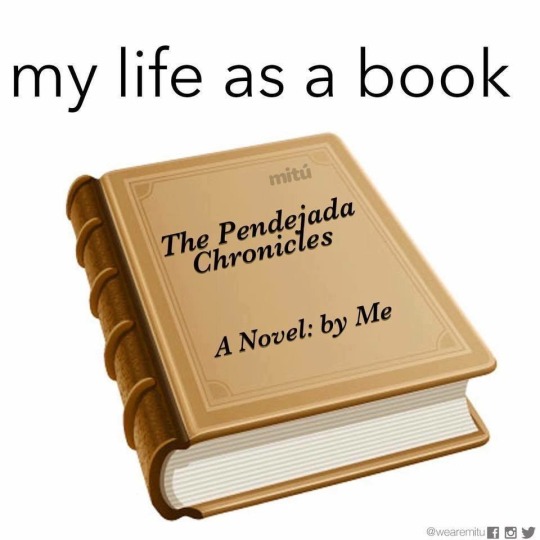
A mis amigos cercanos jamás les volví a contar nada. Que desde ese maldito día estoy muerta por dentro. Si, la puta vida sigue, no hay que darla por sentada y menos estos días. Pero duele y bien culero. Nada me emociona, nada realmente me hace sentir algo. Siento que perdí un pedazo de mi alma y ni siquiera reconozco el peso de mi cuerpo.
Siento que estoy viendo una temporada de relleno en mi vida a la que no puedo adelantarle (de cualquier manera, es más interesante que How i met your má perosigoenamoradodelaRobins) y tampoco le veo fin, ni creo que pase algo que de repente sea el pináculo de mi teleserie.
He perdido novios, ligues, meh, equis, se les llora bien chido por un tiempito, se hacen pendejadas, tus amigos te invitan a salir adelante, te consigues un Pagafantas y no dejan que te hundas en la tristeza. PERO CUANDO PIERDES UN AMIGO ¿Qué se hace?
Los consejos mágicos de “Pues ni modo, a seguir adelante, ánimo, bye girl” no traen un tutorial para saber con qué chingados suplir los pensamientos feos a las 3 de la mañana.
Qué hacer cuando te quieres arrancar el corazón, donde gritar en paz. Porque no importa cuánto me empute, no puedo dejar de quererlo con todo mi ser. Si alguien algún día se siente así a esas horas, escríbanme o márqueme, se siente bien culero estar solo a esas horas, luego te da el pesar de “ay es que me da pena molestar a mis Amix con la misma historia”.
Se van a pasar días de la verga, vas a llorar y llorar y sentir que nunca te termina de pesar el corazón. Vas a sentirte bien otros días y vas a mentarle la madre, pero sabes que en el fondo lo que quieres es otra cosa. Y negocias hasta con el Chaneque que se aparece en la silla que llenas de ropa en tu cuarto. Lo aceptas, das 50 pasos más, y se te abre la puta herida otra vez. Y tú cabecita te juega chueco “¿Ya VeS cOmO No eReS TaN ChIdA cOmO CrEíAs y PeRdIstE a lA PeRsOnA qUe MáS qUeRíAs?”, aparte la gran profecía de que mi miedo más grande se cumplió.
“Aprecia lo que tienes”
Of course, my horse. Mis amigos son la verga, mis papás son las personas más bellas del mundo, mis gatitas son la luz de mi vida, y tengo un trabajo que amo muy cabrón, puedo escribir en Gen, tengo bonito cabello y letra culera. Tengo casiti, comida, ropa negra y calcetas ridículas, y ahorita por fortuna hay salú, mijos. Yo soy mi fan #1, trato de ser lo más Wholesome que puedo conmigo, todo eso que siento por todos ustedes lo siento por mi primero pero no le quita que me siento de la verga porque perdí a alguien a quien adoraba.
Y gracias al internet, tengo acceso a memes felices, que hacen mi vida menos culera y de vez en cuando hace que me bloqueen en Feis.
Si subo tantos memes, es porque ya no tengo a quien mandárselos.
Jamás en la vida he stalkeado a alguno de mis ex novios, ex chuchu o ex amigos. Soy la Gestapo, pero nunca me ha gustado lastimarme sola así. El dolor mismo de saber que alguien existe, pero “ya no está más” es suficiente.
Pensar “no mames, la cuarta temporada de Ricky Martin está poca madre, hijo de tu puta madre por qué verga no estás aquí para discutirla”, ver momazos que nadie más entienda, intercambiar música, artículos, los conciertos a los que íbamos, la comida que nos gustaba, los amigos que hice gracias a él y perder la rutina con tu persona favorita. Solo respiro hondo, y digo “chale, que estés muy bien y seas feliz, feliz” mientras veo a una cámara falsa como si estuviera en “The Office”
Las personas no son eternas, hay amistades o relaciones que solo están destinadas a durar un cierto tiempo, y tampoco nos preparan para cuando las cosas no tienen remedio ni manera de reconciliarse. Hay “Perdones” que nunca se van a escuchar (hey baby girl, perdóname por haberte puesto el cuerno y cortarte valiendo verga si te dolía o nel, perdón mi ciela si te ghostée después de que me confesaste tu amor, ay, ansory maifren hablé culerísimo de ti y les dije a todos tus secretos), hay gente que jamás se volverá a aparecer en tu perra vida y vas a saber que existen y te va a doler bien culero, pero cada vez menos. Pero eso tarda.
Cuando el sidoso Joe me cortó si me hizo mierda un ratón, pero como el amor de mi vida es su mejor amigo, no era tan culero el asunto y aproveché esa época para reinventarme un poco, usando el puto coraje y hasta terminé la maestría. Same shit con Pito de bebé, cuando me mandó a la verga fue mi época más bella y favorita, hice Spartans, salía con chingo de vatos mayores que yoni, tuve novia, le decía SI a todos los planes,y era feliz. Mi primer amor amor amor de juventud y de adultez fue el mismo por años y cuando nos peleamos (también era mi “mejor amigo”) usé ese dolorciti para meterme al gym, ser la mejor en la carrera, ser la más “más” de todo. Cuando me volvió a dejar (hoy somos buenos amigos, pero pasaron más de 10 años), conocí a un fotógrafo mucho más grande que yo que me retó como nadie. No funcionó e hice lo de siempre: andar con alguien idéntico a él, y hasta con el mismo nombre nomás en lo que me encontraba a alguien más que si amara. Siempre hago eso. Amo a alguien, -no funciona – reboundeo – lo dejo por el bueno siguiente o anterior.
Y así una larga lista de Pendejada Chronicles. Siempre que algo me duele, me impulsa. Me tatúo y sigo adelante con más fuerza. Así cierro los ciclos.
Pero ahorita este dolorcito culero, me ahoga. Siento que el corazón me explota y solo me siento segura en el suelo de mi cuarto.
Lo escribo porque ya intenté todo en el manual y todo lo que me recomendó mi terapeuta. Con lo que he llorado, puedo abrir de nuevo el Atlantis en la tercera sección de Chapultepec. Ya hice cartas y las quemé, ya recé, pedí consejos en Reddit, me leyeron el tarot y las arrugas del ano, casi dejo a Colombia sin perico, acaricié perritos, compré en línea, comí helado, me casé, me corté el cabello, le ofrecí mi alma a Rasputín, y nada. Tengo la canción que siempre me saca adelante (Get Over You de Sophie Ellis Bextor) en Repeat perpetuo, pero me dura más tiempo el Feisbuc sin bloquear que la sensación de perrez y paz. Me duele. Extraño a mi amigo.
A veces uno solo necesita quitarse las cosas de encima. Literalmente ya no tenía que perder.
0 notes
Text
So You Want to Make a Tarot Deck, Part 3: Those Extra-Special Touches
You’re deck is almost finished. You’ve finished drawing, or painting or whatever all of your cards. Now it’s all about those special finishing touches.
We talked a little bit last time about borders. Hopefully, you’ve decided on that already. If not, now is the time to do so. Are you going to have them? Is your text going to be included in them? What colour are they going to be? All the same colour, of different for every suit? If you’re not having borders, do you know where your text is going to go, and do you have a bleed on all your cards?
Okay, now it’s time for one of my favourite things: typography. The text on your cards and the font you will use.
Now. I am very particular about this topic. I am probably way too picky for my own good, but I was trained very strictly about text and spacing, and it would be a lie if I said that I didn’t incorporate that training into my current work.
First things first: consistency, consistency, consistency. Pick ONE font. Two, if you must. I know, fonts are fun. There are so many of them, and they all look so pretty. But fonts are powerful things, and they can convey a lot of information. The font you choose should fit the style of your art. And if you start using more than one, you’re going to be giving off mixed messages.
Let’s take some examples.

Ceccoli has a nice serif font, that is simple enough to show off the art, but still has the same formal feel to it. Crystal Visions uses a little more of a unique font, but is still easy to read, and again, has the same feel (feminine, pretty, formal). Joie de Vivre uses script, to fit the loopy art of the deck, the Idiosyncradeck has a lovely sans serif font that supports the minimalistic look of the deck. Houseswives uses two fonts, but they are used consistently throughout the deck.
Let’s go over some basics. Serif font: has the little feet and extra lines (Times New Roman), Sans serif: no extra little lines (Helvetica), calligraphy: looks fancy, rather traditional and like it was written with a quill, Script: looks like handwriting. Never use all capital letters with calligraphy or script fonts, it makes them very hard to read, plus it looks awful.
Every font has a “feel” to it. Some look classy, some look feminine, masculine, fun, serious. When trying to choose a font, look for one that has the same feel as your deck. This is hard to describe, but you’ll know when you see it. Pairing fonts is even more difficult, but you can look on google for that.
Let’s look at some no-no’s.

You see how the Ellis Deck uses a different font for each card? He uses a font that fits the card, not the deck. I hate this. Now obviously you can do whatever you want, but I really don’t recommend it. Silhouettes has the name of the card on the bottom in really small writing. It looks fine, but is rather hard to see and as such, read. The Tarot in Thyme Oracle deck. Yes, it’s a pretty font. I have it as well (Scriptina, I believe). But it can be hard to read. And, since it’s not a major/paid for font, the kerning is shit. You see that space between the T and the H? Bad. There is way too much space in between those two letters in comparison with the rest.
Kerning is a word used to describe the space between the letters. You want it to look equal. If you were to measure it, it wouldn’t be, but it has to look it. You don’t want some letters touching, and the rest not, or have unusually large gaps between some. So, if you are going to use a unique font, you have to kern your text. Google will have tutorials for whatever program you use (if you’re writing by hand, it’s natural). It’s a pain in the butt, but please do this. If you’re using a very popular font (Times, Helvetica, ones you see on every program) the text should already be kerned.
Moving on.
Make sure that you get somebody to proof read and edit for you. Make sure all your spelling is correct, and that you’re not missing something in one of your pictures, or you didn’t use the same picture for two different cards. Another set of eyes is always beneficial.
Look at your deck as a whole. Does everything fit together? Is anything missing? Do the colours all look good together? Does one not match the rest?Did you forget a card? Are you going to add extras, like a Happy Squirrel card, or an artist card?
What about a box? Are you wanting a custom designed tuck box? Are you going to use a tin or maybe a bag? What do you want them to look like? This is something you need to start thinking about.
Have you thought about cardstock? I’m not talking about the quality, I’m talking about the type. Is normal, card worthy cardstock good for you? Do you want your cards to be plastic? Do you want a linen or smooth? Matt or glossy? Do you want any metallic or holographic? If you have something special in mind, you need to be particular with who your printers are, and if they’re are capable of making such things.
tl;dr: decide on borders, pick one good font, make sure to kern it, get somebody (not you) to proof it, think about what kind of box (if any) you want.
Part 1 | Part 2 | Part 3 | Part 4 | Part 5
238 notes
·
View notes
Text
¿WTF es el Tarot? - Bakara Wintner
¿WTF es el Tarot? Un enfoque sensato al antiguo arte de la lectura del Tarot. Bakara Wintner Genre: Spirituality Price: $8.99 Publish Date: January 17, 2019 Publisher: Roca Editorial de Libros Seller: Roca Editorial de Libros, SL SANGRE JOVEN. MAGIA ANCESTRAL. No necesitas aprender tarot porque, sin saberlo, ya lo conoces. ¿wtf es el tarot? rompe con el prejuicio de la visión clásica del arte de la cartomancia, ofreciendo mucho más que un honesto y divertido tutorial sobre la lectura de cartas: arroja una luz holística sobre cómo leer el tarot, desde la base misma de la magia hasta la comprensión de las cartas con significado más críptico. Algo más que una introducción al mundo del tarot, esta divertida y fácil guía ilustrada ofrece un acercamiento único al antiguo arte de la lectura del tarot que te permitirá comprender las cartas a un nivel nuevo y profundo. http://dlvr.it/R1RcKQ
0 notes
Text
EVALUATION OF PROJECT
This evaluation sets out to critically analyse my Final Major Project for Fashion Styling and Creative Direction (BA). It shall look at its initial concept, production and the outcomes both positive and negative as a result.
The Tarot Project, originally named Profectique de Anima (journey of the soul in Latin) has set out, drawing on inspiration from the Tarot, to reimagine its symbolic archetypal figures in a modern way that is both artistic yet approachable. The Major Arcana, which contains 22 cards are representational of themes and archetypes for the person who is being read. The cards that I most felt could be translated into avant-garde images firstly were The High Priestess, The Hierophant, The Fool, Death, The Lovers and Strength. I felt I could do these cards justice, that they offered balance as a series whilst having in mind what was practically possible with the team I had begun to organise. These archetypes were to be transformed into photographic images which initially were to be displayed on an online platform with some use of film used as an introduction to the series.
Tarot and spirituality is something I’ve grown up with from an early age – the project is incredibly personal to me as well as a unique subject that I don’t feel has been explored extensively in modern art and fashion. I was inspired by the traditional Rider Waite deck and its universal themes – aiming to translate my chosen cards into artistic pieces that were modern while maintaining an element of traditionalism. It was important to me to not only do the cards justice but also that the project be refreshing and current as well as cross over the borders of photography, make-up, fashion and art.
The project overall had significant changes made comparing to its proposal. However, I feel that these changes were organic, well thought out and essential to its evolution. One of the first things decided in my first week of this unit is that I would go back to my original idea and have a physical exhibition instead an online one – this is due to me wanting the cards/characters to be physical creations rather than virtual ones. I also felt that I could achieve a higher standard of work with an actual exhibition.
Having started tutorials soon after, I was in two minds whether to have two models. One male and one female model would show necessary distinctions yet one model transforming throughout would be more reflective of the Tarot’s journey – a journey of the human soul essentially. I eventually settled on having two models as I felt this would result in a cleaner outcome as well as distinguish more effectively the male and female energies. Something I wanted to incorporate from the project’s conception was a portrait style, having been drawn to renaissance and pre-Raphaelite paintings. As I developed the final looks my photographer and I both felt that this would be an ideal style for the entire shoot and that it would offer consistency throughout the series.
My team consisted of a photographer friend I from London Isabella Javore, Marilena Angelopoulou from my year, Yoiwan Kong whose avant-garde make up artistry was perfect for the project, her assistant Erin Stacey and Lorhaine Mendes from my course also whose look I felt would bring an edge to the female looks. Something I did not plan on most definitely was fulfilling the male roles in the shoot. Yoiwan had suggested it and although hesitant at first I decided it was the best decision. I knew the moods I wanted to convey, my look would work well and overall it brought this personal project together. The final looks consisted of seven archetypes/themes with some changes I felt essential – The Fool, The High Priestess, Strength, The Lovers and Death would be accompanied by The Magician and The Star. This offered some variation between the archetypes and completed the series for me. All images were shot with a black colourama to balance out the make-up and styling which also allows ties the images together as a collection.
Beauty and mid-length shots were the focus throughout and the looks were split into two shoots, two weeks apart. This did pose several issues and worries initially as the shoot originally was meant to be over two consecutive days. Consequently, the shoots not only had a week apart but also meant a new photographer had to be used. My good friend Marilena Angelopoulou therefore took Isabella’s place. Although this was by no means planned, Marilena was very well aware of the project’s technicalities, being present at the first shoot. The second shoot ran smoothly and effectively.
The use of props, colour and graphic make up for me ties the key ideas together. The white rose is essential to the start of the story – The Fool – and also its appearance in Death representing both youth and endings. The crystal ball The High Priestess holds signifies her wisdom and feminine power, the apple’s ambiguous connotations in The Lovers and the bound book in The Magician are all central in representing each chapter of the series. It was important for me that a modern edge was given to all the looks – this is perhaps best seen in the painterly faces given to The Fool and Death and the final edit of all the images which possess something slightly undone.
Looking at the project at its completion I can say I am happy with the outcome but also aware that there are several ways it could have been developed – as well as not feeling like I completed everything I set out to do. I am most disappointed by the fact that although I did change the exhibition to a virtual one, a film was still not created. This would have not only shown the project on a multiple of platforms but would have truly created something visually powerful that could be accessed online. Music, sound and movement could have been incorporated also with a film. In terms of the images themselves however, for me they are a great success – being high quality as well as incorporating all the elements I wanted to include.
As I begun to finalise the last few details of my exhibition and with the aid of my mentor, The Tarot Project progressed further in a way that I had not planned at all. While discussing the final outcome and several ideas my tutor and I came to the decision of exhibiting four out of seven of the images at the Art House as planned but combining this with a tarot box version also. The seven images would be displayed in A6 form at the exhibition and a box, along with a crystal and candle, would be submitted physically as a set. The cards were exhibited on a ‘Readings’ style table along with the enlarged A3 images. Adding a tarot box allowed my project to take another form, becoming an artistic keepsake and even has the ability to be used for a mini reading.
The A3 images themselves were hung on a plain white wall in the Art House, accompanied by a professional artist write up and labels below each image. It’s important to note here that it was when I was writing my artist page for the exhibition I finally decided to change the name of the project officially to The Tarot Project. It was what I called it naturally throughout the project’s progress and I felt it less cliché and modern than Profectique de Anima which felt slightly pretentious as well as not particularly inviting. I can’t say that I was or am ecstatic about the exhibition space, though it did allow me to play music, burn incense and create my own set up as well as have refreshments which many places would have had an issue with.
As an age bracket of people aged between 20-30 mostly attended the exhibition, I feel it was successful in attracting a creative and artistic group who either had a very keen interest in mysticism and spirituality or were attracted to dramatically styled images. However, again, I feel the project needed a film to accompany the images which would have modernised the series, given it more life and perhaps initiated a far more emotive connection between the subject and viewer.
Even though I set out to create 6-7 images, if time and finances allowed I would have definitely extended the archetypes/themes to perhaps double the amount and have blown the images up to A2 or A1 size. This would have allowed further exploration into the Tarot and its meanings as well as be more visually impressive. On the whole it would also be more reflective of the journey of the Major Arcana. I am however very interested in taking the project further and adding new creations to the series as well as producing a film. My first photographer and I, Isabella Javore, are not only very close but share the same passion for the Tarot. Therefore, when we feel we can, we are planning to see The Tarot Project’s progression and completion.
I have learnt so much from my Final Major Project as well as thoroughly enjoyed its process. The importance of a reliable, skilled team was and is crucial for a positive outcome of any project. It also gave me a true taste of what working in industry will be like and effective collaboration. Organising the exhibition was one of the most stressful procedures but I’m also proud of how I handled it’s planning and of all my work overall. The culmination of my University experience, I can honestly say has given me confidence in taking my next steps in the creative world and in my personal development as a creative individual.
1 note
·
View note
Text
NEVER EVER call yourself a dumbass because you asked for good, verified information from people who already know what they're doing. If someone does call you a dumbass because of that, then that's bullshit.
Books and apps are really fricking great for self-learning, but you have to remember to talk to people, even online (sometimes preferably online, because of living situations), because not only can you really clarify some of your questions, talking to like-minded individuals feels fantastic.
BOOKS:
The Encyclopedia of Witches, Witchcraft and Wicca by Rosemary Ellen Guiley. It's a bit dry, but leaves you with an ecstatically long reading list to follow-up on (tip: unless you find it really interesting, only add it to your reading list if the books under the "Further Reading" tag showed up multiple times).
Protection & Reversal Magick: A Witch's Defense Manual by Jason Miller. He expects you to know the basics, but he does give a quick run down of the definitions he's using in the preface. ALSO, he actually teaches you defensive magick instead of just handing you prewritten spells and calling it a day.
Eight Sabbats for Witches by Janet and Stewart Farrar. A lot more Wicca-centric than might be for the best, so don't be afraid to cut-and-paste around the only useful parts. It does give you the basics around the Sabbats, and that's part of what many consider Witchcraft 101.
APPS (these are on Android btw):
Tip: When looking for apps, don't search under the tag "Witchcraft" because you'll have to dig through a bunch of games, instead use "Spiritualism" because that's what most people use.
Aldiko Classic by De Marque is a really good free ebook (epub, pdf, audio) reader that I've been using since childhood. It has a brief but understandable tutorial, and is super user-friendly without it. Bonus; you can change the info of the books (cover, title, author) themselves so you can either make it look as aesthetically witchy as you want or do the complete opposite!
IbisPaint X, aka free (relatively, some of the brushes are locked but you can watch ads for them) Photoshop in Android. Made by ibis inc., it has a small learning curve, but is great for everything. I incorporate art into my practice but it's super useful for sigil work. Also its Free Photoshop, on your phone!
Moon by Black Swift. Moon phase app, has some locked features but still very usable without the bonus features. Honestly I don't use it very often, I prefer timeanddate.com for my astrology needs.
Labyrinthos Academy is hands-down the BEST tarot app. Ever. The app itself teaches you Tarot 101 in this super fun way, on three decks you can choose from. Completely free! Once you got the basics down pat, you can check the other apps that are again completely free, but lets you do comprehensive readings with one of the three decks available with Labyrinthos Academy.
Runic Divination by Evansir is the most comprehensive rune "casting" app I've found. It doesn't actually throw the runes, just lays them in classic tarot spreads, but it still works.
Dice by Alexander Hicks, was meant to be used for dnd, but I personally use it for Astragalomancy. Astragalomancy is divination by throwing dice, and I really like it because it's very dependent on your personal interpretations.
OTHER RESOURCES:
pdfdrive.com is a great book resource if you are broke! The books are free if of relatively poor quality but definitely readable.
Tumblr is surprisingly good? with witchcraft resources. If you're a beginner try tag "baby witch", and then dig around in "witchblr" and "witchcraft". I suggest heatherwitch, and growing-yet-into-magic for general witchy stuff.
Mumblesandthings.com and thetravelingwitch.com are my go-to witchcraft blogs away from tumblr.
Talk Witchcraft with Maggie Haseman is a podcast that really great with Witchcraft 101! Maggie also regularly posts free resources with the podcast episodes on her blog (which is Mumbles and Things).
Does anyone have any good PDFs and free apps on witchcraft? I'm looking to start practicing, but I'm a little lost and I have little money...
Sorry if I sound like a dumbass.
#witchcraft#witchblr#beginner witch#baby witch#waysearching#masterpost#tarot#rune casting#astragalomancy#books#sigils#podcast
12 notes
·
View notes
Text
11 Ways to Wind Down from a Stressful Day
New Post has been published on https://healingawerness.com/news/11-ways-to-wind-down-from-a-stressful-day/
11 Ways to Wind Down from a Stressful Day
The world has felt heavy lately. Stress is real when pandemics aren’t happening but add a pandemic and we’ve reached new levels, folks. I have recognized what has been helping me relieve stress over the past few months and wanted to share these ideas with you. Spoiler alert: they don’t involve social media, TV or wine.
11 Ways to Destress from a Stressful Day
Journal – Sometimes before I can do anything else, I need to get all of the thoughts circling my brain out. Grab a scratch piece of paper or a notebook and just start jotting down all of your thoughts. Don’t worry about complete sentences just write! I like to start with this so when I move onto something else, my brain has freed all of these thoughts. Journaling hack: if you’re feeling stuck, try pulling a tarot card and see what thoughts come up from that.
Meditate – I know this one can feel big and overwhelming but there are so many easy ways to meditate these days! Find a YouTube video of a meditation that you connect with or download an app that provides quick meditations. It can take five minutes or less and makes a huge difference! My favorite app is Insight Timer– it’s totally free!
Read – One of the best ways for me to “escape reality” is to crack open a book and get lost in the storyline. I like to stick to fiction books on stressful days because honestly, I don’t want a self help book or real story! Here is some recommended reading.
Art – This one will scare some of you… trust me, I know. So many of us have been told we aren’t artsy or creative but that is a flat out lie. Find something that you enjoy, that brings you peace and do it! You don’t have to be a professional or making money off it. In the past year, I’ve taken a stab at watercolor (I love this nature watercoloring book!) and handlettering and highly recommend both. It has been such a fun way for my hands and brain to stay busy. I also started making homemade cards for friends.
Diffuse – It’s a tradition for me to diffuse some calming essential oils in my diffuser to cue up a stress-free evening. Some of my favorites include lavender, neroli and sandalwood – all known for the calming properties!
Move – As you probably know, I’m a yoga junkie. I looove an at home yoga practice and find that some gentle movement really helps my stress levels! If you’re not into yoga, go for a walk around your neighborhood or do a different type of workout.
Blend a Tea – You may remember that last year I completed my herbalism course. Learning about the benefits of all different kinds of herbs was eye-opening and fascinating to me. Generally I like to take stock of how I’m feeling and blend together a few herbs to make a nice herbal infusion. When in doubt, check out my stress-reducing tea recipe or grab a pre-blended tea you love. Pair it with a sweet treat that makes you happy and take time to sip thoughtfully and slowly to really savor the experience.
Play a game – One of my new favorite ways to pass the hours is by playing games! Card games, board games… the whole shebang. If you don’t have a partner, roommate or friend that can play with you, highly recommend puzzles! Other options: Jackbox TV, an apple tv game set that you can play virtually with friends!
Take a bath – I am a total bath junkie. I love to do a full-blown spa night as often as I can. I’ll light a candle, use some bath salts, put on a face mask and grab my kindle. I honestly could spend hours in the bath and occasionally have to be coaxed out cause I’ve turned into a wrinkly prune.
Dance – No one has to know about this one… ha! Close those blinds and move! Do you know how much dancing improves my mood? Freestyle it by turning up some jams or get crazy and follow a dance tutorial on YouTube. Both fun, both amazing at de-stressing! Check out The Healthy Maven’s Spotify for some music inspo (highly recommend Ladies who Rock for an all out dance sesh).
Sleep – If all else fails, I highly recommend hopping in bed and getting a good nights sleep. Mornings are always easier than nights for me, new days bring a sense of a fresh start.
Like this post? Here are a few others you might enjoy:
JOIN THE THM NEWSLETTER
Join 10,000+ members of the THM Community to get access to exclusive recipes, healthy lifestyle tips and behind-the-scenes news from our team!
Source: http://feedproxy.google.com/~r/TheHealthyMaven/~3/c3IyMuYDYxU/
0 notes
Photo

Hoy nace el #TarotMakeUpChallenge dónde @vi.morfin va a realizar un make up inspirado en cartas del tarot. El primer look está inspirado en la reina de bastos. Puedes encontrar en el ig de @vi.morfin el tutorial para poder recrear este hermoso #makeup Cuando hagas y subas tu look a tus ig stories o a tu feed etiquétanos y usa el #tarotmakeupchallenge https://www.instagram.com/p/CDtsOpDjyJV/?igshid=19a51t1l7z66e
0 notes